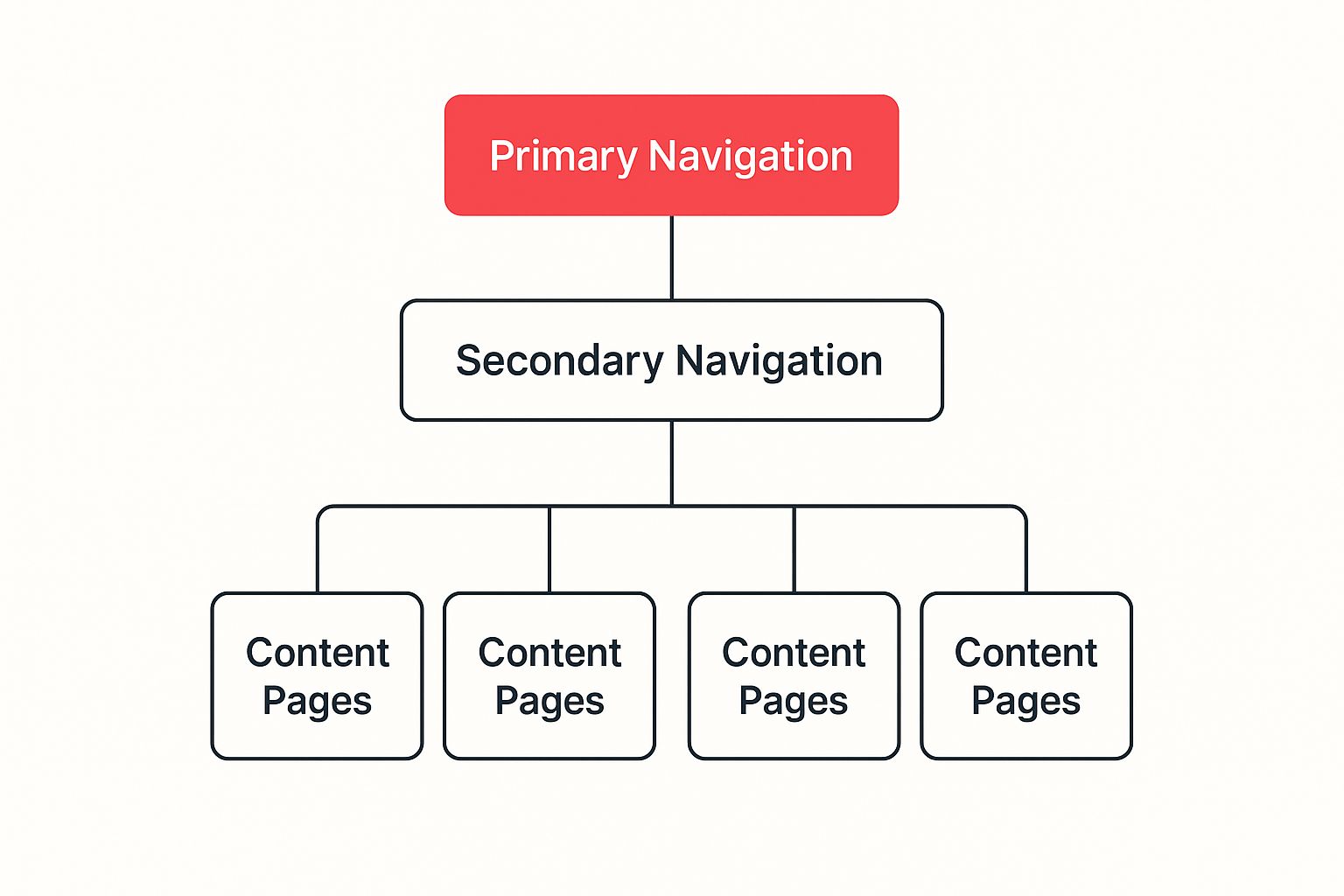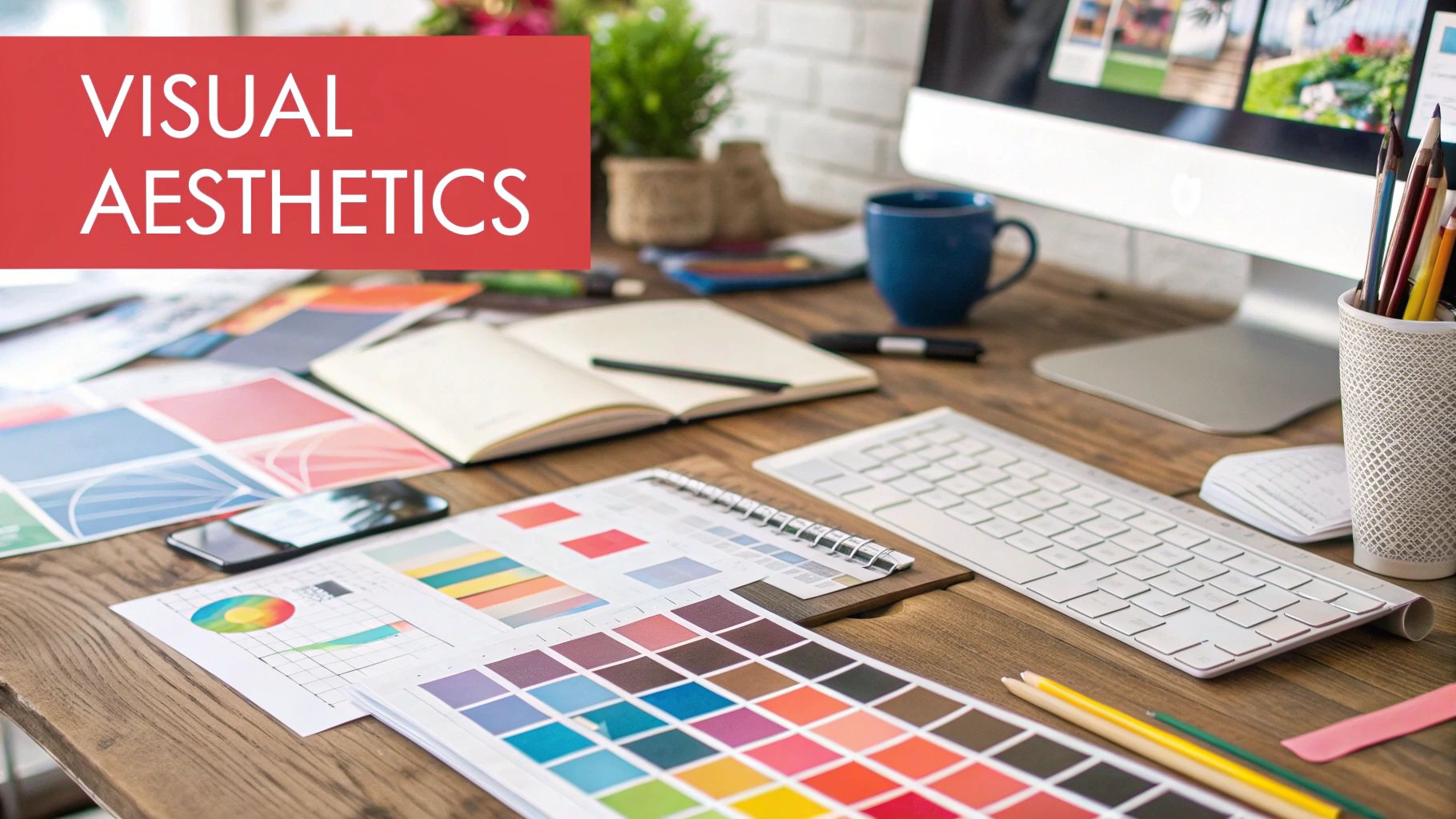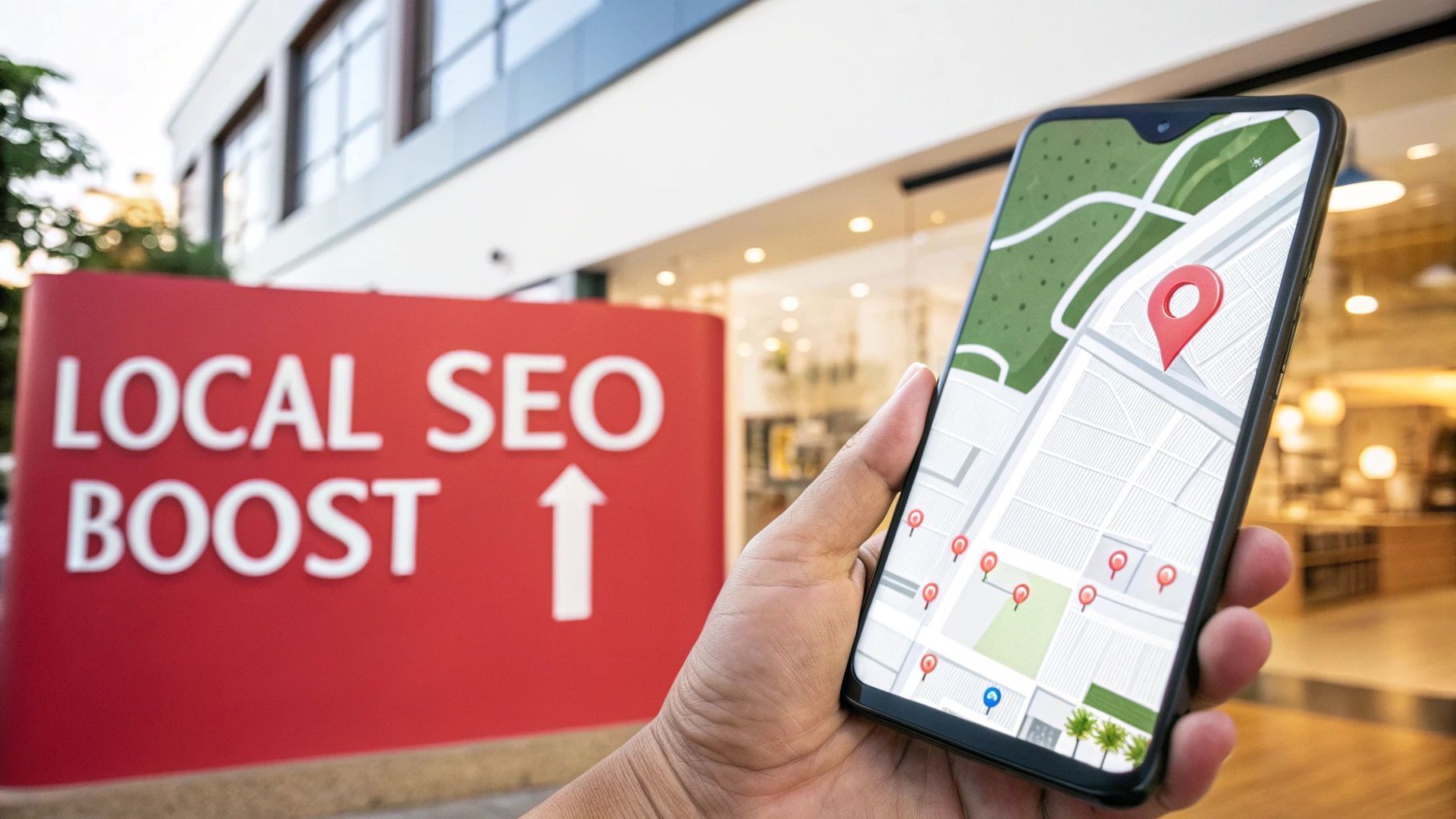Master User Experience Design Principles for Better UX
User experience design principles are the invisible architecture of any great digital product. They are not a rigid checklist of rules you have to follow, but more like a guiding philosophy for creating things that people find intuitive, effective, and even enjoyable to use.
So, What Are UX Design Principles, Really?
Think of UX design principles like the blueprints for a house. An architect does not just throw doors and windows wherever they feel like it. They rely on proven principles of structure, flow, and safety to design a space that is not just nice to look at, but is actually liveable and easy to move around in.
Without that foundational thinking, the house would be a confusing, frustrating mess. It is the same in the digital world. These principles give a website or app a solid, user focused foundation, making sure every interaction feels logical and satisfying.
This framework is so important because it shifts design decisions away from someone's personal taste ("I like the blue button") and towards objective, proven strategies that genuinely work. Before diving deeper, it helps to understand the bigger picture. A solid definition of What is User Experience Design makes it clear that the whole discipline is about how a person feels when they use a product.
The Real Purpose Behind the Principles
At their heart, UX design principles do two jobs at once. First, they act as the user's advocate, making sure the final product actually solves a problem without creating a bunch of new headaches. Second, they tie the design work directly to business goals, because a happy user is far more likely to stick around and become a loyal customer.
When you get them right, these principles create a perfect bridge between what a user needs and what the business is trying to achieve.
The goal of a designer is to listen, observe, understand, sympathise, empathise, synthesise, and glean insights that enable him or her to ‘make the invisible visible.’ — Hillman Curtis
Take a principle like Consistency , for example. All it means is that similar elements should look and act in a similar way across the entire product. It is a simple idea, but it massively reduces the user's cognitive load—they do not have to constantly relearn how things work on every new screen.
This directly improves usability and builds a sense of trust. That trust, in turn, strengthens brand loyalty and helps the business succeed. The principles give everyone on the team, from designers to developers, a shared language to build something that is cohesive and truly valuable.
Why Great UX Is a Smart Financial Decision

Putting your budget into user experience is not just about aesthetics or making things look nice; it is one of the sharpest financial moves a business can make. When you apply solid user experience design principles , you are not just creating a product that is a pleasure to use. You are building a powerful engine for business growth.
Picture a clunky, confusing online shop. If a potential customer cannot figure out how to find what they want or navigate the checkout, they are gone. They will abandon their cart in frustration and head straight to a competitor with a smoother process. This simple scenario gets to the heart of it: great UX removes friction and makes it incredibly easy for customers to say "yes".
This intense focus on usability delivers real, measurable results. Businesses that get serious about UX almost always see a major uplift in the key performance indicators that the boardroom actually cares about.
The Financial Benefits of Prioritising UX
Committing to a user first design approach is not just about keeping people happy—it is about building a more profitable and resilient business. The returns show up in several critical areas, all contributing to long term success.
These benefits do not happen in isolation; they create a powerful cycle of growth. A better experience leads to higher satisfaction, which builds loyalty and drives repeat business. It is a flywheel effect that directly strengthens your company's financial health.
Here is where you will see the impact on the bottom line:
- Improved Conversion Rates: By making it simple for users to do what they came to do—whether that is buying a product or filling out a form—you directly boost your conversion numbers. This is especially clear when you look at the anatomy of a high-converting landing page , where UX is everything.
- Increased Customer Retention: A positive, seamless experience gives customers a reason to come back. In fact, studies show that a staggering 88% of online consumers are less likely to return to a website after a bad experience.
- Lower Support Costs: When a product is intuitive, users can figure things out on their own. They do not need to jam up your support lines, which cuts down your operational overheads significantly.
- Enhanced Brand Reputation: A name for creating high quality, user friendly products is an invaluable asset. It pulls in new customers through word of mouth and glowing reviews, doing your marketing for you.
A Growing Market Reflects Its Value
You do not have to take our word for it—just look at the market. The European user experience market, which includes the UK, was recently valued at around $1.875 billion . That number is set to grow at a compound annual rate of about 12.3% between 2025 and 2033.
This is not a fluke. The growth is being driven by smart organisations that are investing heavily in UX to get a serious competitive edge. You can dig into more insights about the European UX market on cognitivemarketresearch.com.
Investing in UX is no longer a luxury—it is a fundamental business requirement. Every pound spent on improving the user experience is an investment in customer loyalty, conversion, and long term brand equity.
At the end of the day, the data tells a clear story. Applying proven user experience design principles is not an expense. It is a high return investment that pays for itself many times over through more revenue, stronger customer relationships, and a lasting advantage in the market. For any business leader, embracing UX is simply smart finance.
The Core Principles of Effective UX Design
To really get what user experience design is all about, we need to move past the fluffy ideas and dig into the practical, hands on principles that are the foundation of any decent digital product. These are not just abstract theories you learn in a classroom; they are the real world rules that make the difference between a product that feels natural and one that is just plain frustrating.
Think of these core principles as a shared language for design teams. They ensure every decision, from where a button goes to how a menu works, is made with the user firmly in mind. Let us break down the most important ones.
Mastering Hierarchy for Intuitive Navigation
Visual hierarchy is all about arranging things on a screen to show what is most important. Picture the front page of a newspaper—the massive headline grabs your eye first, then the smaller subheadings, and finally the article text. It is not an accident; it is a deliberate design choice to guide you to the main story instantly.
In digital design, we do the same thing using size, colour, contrast, and placement. When you get the hierarchy right, people do not have to waste time hunting for what they need. Their eyes are naturally pulled towards the main call to action button, the navigation bar, or the most important bit of information. This makes using the interface feel easy and reduces mental effort.
This diagram shows how a clear structure guides someone from a general starting point to the specific content they are looking for.

As you can see, a logical flow from the main navigation to deeper content pages is crucial for creating a user journey that feels predictable and simple to follow. Without it, people get lost and confused pretty quickly.
The Power of Unwavering Consistency
Consistency is one of the absolute cornerstones of user experience design. It simply means that similar elements should look and behave in the same way right across your product. This predictability builds a sense of trust and makes your interface feel reliable.
Imagine if stop signs were sometimes red octagons, but other times green triangles or blue squares. It would be total chaos because you would have to relearn the rules at every junction. Consistency in design prevents this kind of digital mess by creating a stable, familiar environment.
An inconsistent user experience means people will have trouble using parts of a product or might have to relearn how to use it with every feature release or update!
This applies to everything, from the colour you use for clickable links to where you place the search bar. When people know what to expect, they can get things done with confidence and speed, focusing on their task instead of trying to figure out your design. If you are looking to apply this, exploring some essential website design best practices is a great place to start.
Providing Clear and Immediate Feedback
Feedback is all about letting people know what is going on. Every single action a user takes should cause a noticeable reaction from the system. When you tap a button, it should look like it has been tapped. When a page is loading, a progress bar or spinner should show that something is happening behind the scenes.
This constant communication is vital. Without feedback, users are left wondering if their click even registered or if the app has just frozen. That uncertainty is a fast track to frustration and a complete loss of trust.
Here are a few classic examples of good feedback:
- Success Messages: A quick "Your message has been sent!" pop up after you submit a contact form.
- Error Highlighting: A red border appearing around a field you have filled in incorrectly.
- Loading Indicators: A spinning wheel that shows up after you click something, letting you know the system is working on it.
These little interactions make the experience feel responsive and alive. They are the digital equivalent of a nod or a "got it" in a real conversation.
Prioritising Usability Above All Else
At its heart, usability is just a measure of how easy something is to use. A product with great usability lets people achieve their goals efficiently, effectively, and without pulling their hair out. It is really just the practical result of applying all the other principles together.
Think of a well designed kettle. It does one job: boil water. The handle is comfortable, the lid opens easily, the spout pours without spilling, and the 'on' switch is obvious. You do not need a manual because its design tells you exactly how it works. That is peak usability.
The very same goal applies to websites and software. People should not have to think hard to do basic things. The design itself should be the guide, making the path to their goal as smooth and obvious as possible. The only real way to know if your design is usable is to test it with actual users—what seems obvious to a designer is often confusing in the real world.
Designing for Universal Accessibility
Finally, we have accessibility. This is the principle of designing products that can be used by everyone , regardless of their abilities. This includes people with visual, hearing, motor, or cognitive impairments. It is easy to dismiss this as a niche issue, but designing for accessibility actually makes your product better for all users.
For example, using high contrast text does not just help people with visual impairments; it also makes your screen easier for anyone to read in bright sunlight. Likewise, using clear and simple language helps users with cognitive disabilities, but it also makes the content easier for everyone to scan and understand quickly.
Making your product accessible is not just the right thing to do—it is also a legal requirement in many places and a smart business decision that opens up your product to a much wider audience. It is about ensuring the digital world is genuinely open to all.
To wrap things up, these principles are not just a checklist to tick off. They are the foundation of thoughtful, user focused design. Here is a quick summary to keep in mind.
Key User Experience Design Principles Explained
| Principle | Main Goal | Consequence of Neglect |
|---|---|---|
| Hierarchy | Guide the user's attention to the most important elements first. | Users feel lost, confused, and cannot find what they need. |
| Consistency | Create a predictable and learnable interface. | Users get frustrated and must relearn how to use the product. |
| Feedback | Communicate the result of a user's action clearly and immediately. | Users feel uncertain, wondering if the system is broken or slow. |
| Usability | Ensure the product is easy, efficient, and satisfying to use. | Users abandon tasks, conversion rates drop, and satisfaction plummets. |
| Accessibility | Design products that can be used by people of all abilities. | You exclude a large portion of the population and miss opportunities. |
By keeping these core ideas at the forefront of your design process, you shift from simply building features to creating genuinely effective and enjoyable experiences for real people.
Putting UX Principles into Practice
Knowing the theory behind user experience is one thing. Actually turning those ideas into a product that people love to use? That is a whole different game. This is where the real work begins, translating abstract concepts like ‘Feedback’ or ‘Consistency’ into the tangible features you build every day.
It is about more than just ticking boxes. It is a mindset. The goal is to weave these principles into the very fabric of your design and development process, making them the foundation, not an afterthought. When you get this right, every single decision you make is guided by what your users truly need and expect. The result is a product that does not just work, but feels completely intuitive.
Starting with Deep User Understanding
Before you even think about sketching a wireframe or writing a single line of code, you have to know who you are building for. This all starts with user research —the critical first step to uncovering the real motivations, behaviours, and frustrations of your audience. If you skip this, you are basically designing with a blindfold on.
User research is not a single activity but a collection of methods designed to give you the full picture. Each technique offers a different lens through which to see your user's world.
A few common methods include:
- User Interviews: Real, one on one conversations where you can explore people’s habits, needs, and pain points in their own words.
- Surveys and Questionnaires: Great for gathering specific data from a large group to spot broader trends and patterns.
- Observational Studies: Simply watching people use existing products or go about their day. You see what they actually do, not just what they say they do.
This foundational work is non-negotiable. It forces you to consider principles like 'Accessibility' from the very beginning by including a diverse range of people, and it stops your team from making bad assumptions based on personal bias.
Visualising the User’s Journey
Once you have a solid feel for your users, it is time to map out their entire experience. A customer journey map is an incredibly powerful tool for this. It is a visual story that charts every single interaction someone has with your product, from the moment they first hear about it to becoming a long term fan.
This map details what they are doing, thinking, and feeling at each step, which is brilliant for spotting moments of joy and, more importantly, points of friction. For example, a journey map might show that people feel anxious at the checkout because there is no clear confirmation—a classic violation of the 'Feedback' principle.
A journey map is a visualisation of the process that a person goes through in order to accomplish a goal. It combines storytelling and visualisation to help teams understand and address customer needs.
By creating this visual guide, you get a strategic roadmap for your design. It points you directly to the spots where applying user experience design principles will have the biggest impact, helping you prioritise the fixes that will solve real world problems.
Structuring the Experience with Wireframes and Prototypes
With a clear picture of your user and their journey, you can finally start shaping the interface. Wireframing comes first. Think of it as the architectural blueprint for your product—a simple, low fidelity sketch focused purely on structure, layout, and where key elements go. It helps you nail down principles like ‘Hierarchy’ and ‘Consistency’ without getting distracted by colours and fonts.
From there, you move on to prototyping , creating interactive mock ups that simulate how the final product will work. These can be anything from simple clickable wireframes to high fidelity designs that look and feel just like the real thing. This is where your principles are truly put to the test. Does the flow make sense? Is the feedback instant and clear? It is the perfect time to get the design in front of real people for some early thoughts. Of course, before starting the full build, it helps to understand the key stages of the process, as detailed in this guide on what you need to know about website development.
Validating Designs Through Usability Testing
Finally, no design is truly finished until it has been tested by the people who will actually use it. Usability testing is the practice of watching real users try to complete tasks with your prototype or product. The goal is not to ask them if they like it, but to see if they can use it.
These sessions are where the truth comes out. You might discover that a button you thought was obvious is constantly being missed, or that the wording on a form is just plain confusing. For those on mobile, mastering mobile app usability testing is an essential skill for creating products that do not just look good, but feel great to use.
By building these practical steps—research, journey mapping, wireframing, and testing—into your workflow, you take those abstract user experience design principles and turn them into a reliable system for creating genuinely brilliant products.
Why UX Design Is Vital Across UK Industries

The secret is out. Strong user experience design principles are no longer a niche concern for tech start ups. All across the UK, organisations in every imaginable sector are waking up to a simple truth: a smooth, intuitive digital experience is not just nice to have—it is absolutely essential for survival.
This is not just a trend; it is a fundamental shift in how business is done.
From the high stakes world of finance to local council services, the hunger for skilled UX professionals has exploded. Companies now realise that investing in user centred design is not a cost but a core strategy for staying competitive. It is a clear signal that UX has become the versatile problem solver for a huge range of modern business challenges.
The Impact on UK Finance and Healthcare
Take the UK finance sector. For years, tasks like applying for a mortgage felt like navigating a maze. Now, user experience is the key differentiator. Banks and fintech challengers are pouring resources into UX to simplify these complex processes, making them accessible and building trust through clear, easy to use platforms.
It is a similar story in healthcare. The NHS and private providers are applying user experience design principles to transform everything from clunky appointment booking systems to patient portals. Get the design right, and you can genuinely reduce patient anxiety and lighten the administrative load, which means better health outcomes for everyone.
Good user experience is a universal language. It speaks to the fundamental human need for clarity, efficiency, and a sense of control, regardless of the industry or context.
This demand is not just anecdotal. Research confirms that the need for UX expertise in the UK is rock solid across an incredibly diverse range of industries, from finance and healthcare to education and charities. As organisations everywhere prioritise user centred strategies to win loyalty and gain an edge, the field has moved far beyond its tech origins. You can dig deeper into this growing demand for UX design across UK industries on intelligentpeople.co.uk.
Driving Change in Retail and Government
The retail industry has always been obsessed with the customer journey. That obsession has now gone digital, with e-commerce sites and apps being carefully engineered to create shopping experiences that feel effortless.
This is all about applying core UX principles to:
- Simplify Navigation: Making sure shoppers can find what they want instantly with logical categories and a search bar that actually works.
- Streamline Checkout: Slashing the number of steps it takes to pay and removing any friction that leads to abandoned carts.
- Personalise Journeys: Using data to serve up relevant recommendations that make customers feel seen and understood.
Even government services are getting a user centred makeover. Think about renewing your driving licence online or accessing local council services. The goal is the same: create straightforward, accessible, and efficient digital platforms that work for every citizen. This widespread adoption is proof that mastering user experience design principles unlocks a stable and rewarding career path across the entire UK economy.
What a Career in UX Looks Like in the UK
Getting to grips with user experience design principles is not just about making better products. It is a ticket to a stable, well paid, and genuinely rewarding career path, especially here in the UK. The demand for skilled UX professionals has exploded across almost every industry, creating a seriously competitive market for talent.
This is great news for you. It means salaries are on the rise and the routes for career progression are clearer than ever. It makes UX design a solid choice for the long haul.
A typical journey starts in a junior role, where you will likely be supporting senior designers, getting your hands dirty with research and early stage wireframing. Before you know it, you will move into a mid weight UX Designer position, taking on more ownership of projects. As you build up your experience, you can aim for Senior UX Designer, Lead, or Manager roles, where you will be shaping strategy and mentoring the next generation of talent.
What Can You Expect to Earn?
Let us talk money, because the financial rewards are a huge part of the appeal. In major tech hubs like London and Manchester, the scramble for top tier talent is fierce, and that has a direct, positive impact on what you can earn. Companies know they need to offer attractive packages to get people who can make a real difference to their products and bottom line.
Salaries in the UK UX scene are strong, reflecting the immense value these roles bring. According to the latest data, the average salary for a UX Designer in the UK hovers around £60,000 . That number climbs steeply with experience. Senior positions, like a UX Director, can command an average of up to £125,000 .
It is not just designers, either. Specialists in related fields also see impressive earnings. Product Designers and other UX focused roles can expect to earn between £55,000 and £150,000, depending on seniority and expertise. For a deeper dive into the numbers, check out the latest UK product design and UX salary data on intelligentpeople.co.uk.
Key Roles and Progression Paths
The UX field is not just one size fits all. It is a broad church with plenty of room to specialise, which opens up some really exciting and diverse career opportunities. While every role is grounded in core user experience design principles , each one applies them in a unique way.
Some of the most common career paths include:
- UX Researcher: The detective of the UX world. You will focus on understanding what makes users tick, using interviews, surveys, and testing to get inside their heads. This role is the bedrock of any truly user centred design process.
- UX Writer: Words matter. As a UX Writer, you will craft every piece of text a user sees, from button labels to error messages, making sure the language is clear, helpful, and on brand.
- Interaction Designer: This is all about the flow. You will concentrate on how users move through a product, designing the specific interactive elements that make the entire experience feel smooth, intuitive, and almost effortless.
The explosion in UX careers is a direct reflection of a market that finally gets it. Companies are no longer asking if they should invest in UX, but how much and how fast.
All in all, the career landscape for UX professionals in the UK is looking exceptionally healthy. With clear paths for progression, a growing number of specialisations, and highly competitive salaries, it offers a sustainable and fulfilling future for anyone passionate about the craft of building better digital experiences.
Your Questions About UX Design, Answered
As you get more familiar with user experience, a few questions always seem to come up. It is completely normal. This final section is all about tackling those common queries head on, giving you clear, straightforward answers to cement your understanding of the core user experience design principles .
What Is the Real Difference Between UX and UI Design?
Let us think about it like building a house.
UX (User Experience) is the architect's blueprint. It is the entire foundation and structure—how the rooms flow into each other, where you put the doors for easy access, and whether the overall layout actually works for the family living inside. It is all about the logic and feeling of the experience.
UI (User Interface), on the other hand, is the interior designer's job. This is the stuff you see and touch: the colour of the walls, the style of the furniture, the type of light fittings. UI is focused on the visual and interactive elements.
You cannot have a great home with just one. You need both a solid blueprint and beautiful decor. It is the exact same for a digital product.
UX is the entire journey a user takes to solve their problem. UI is the look and feel of the surfaces they interact with along the way. One simply cannot function without the other.
How Many UX Principles Do I Actually Need to Know?
Honestly, there is no magic number. While we have covered essentials like Hierarchy, Consistency, and Feedback, there are dozens of different frameworks out there. The real goal is not to memorise an endless list, but to truly get the mindset behind them.
Start by asking the most fundamental questions:
- Can people find what they need without thinking too hard?
- Does everything work in a way they would expect?
- Does the system tell them what is happening after they click something?
If you focus on answering these simple questions for your user, you will find you are already applying the most important user experience design principles without even trying to. It is about intuition, not just theory.
Ready to put these principles into action and build a digital presence that truly connects with your audience? The expert team at Superhub is here to help you craft intuitive and effective user experiences. Visit us at https://www.superhub.biz to get started.





